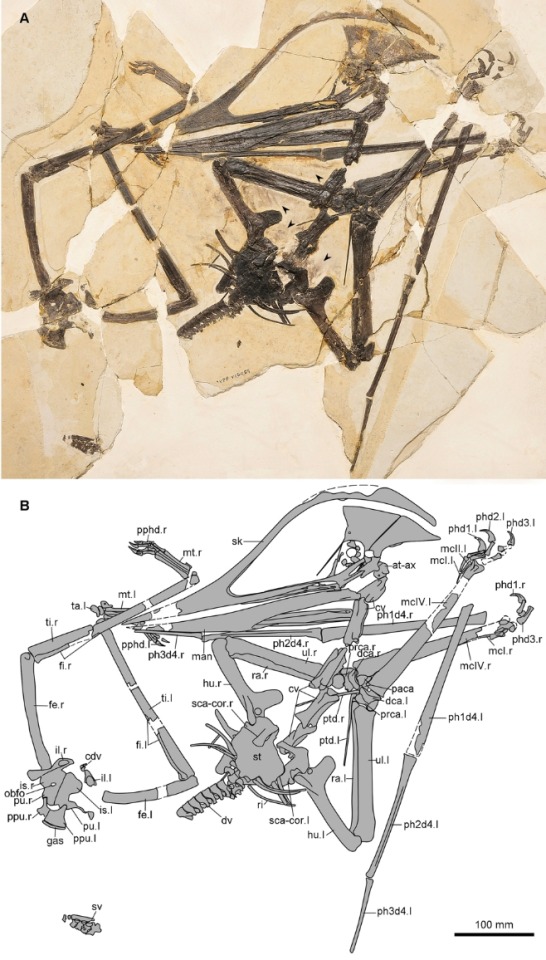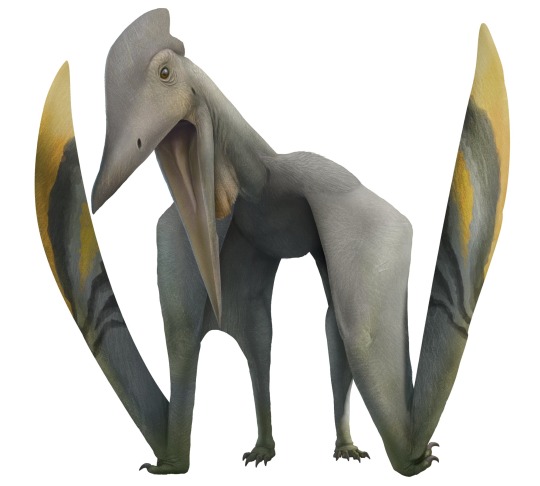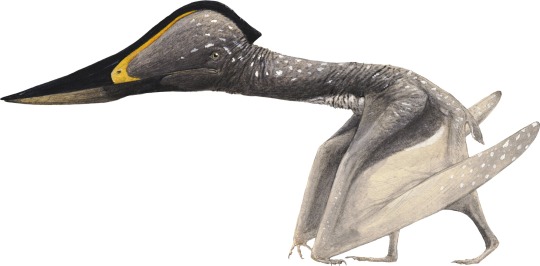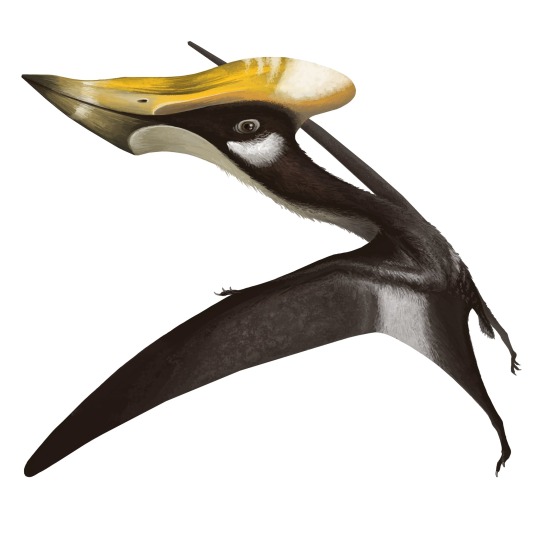#chaoyangopteridae
Explore tagged Tumblr posts
Text

#is it me or are the weird dogs getting bigger#he looks hungry#should i?#should i do it?#should I give him a French fry#french fries#weird#strange#weird horse#weird dog#there’s a weird horse in my yard#weird dog series#lacusovagus#chaoyangopterid#chaoyangopteridae#azhadarchid#azhdarchidae#azhdarchoid#azhdarchid#azhdarchoidea#crato formation#night#pterosaurs but now#pterosaur post#pterosaur#avemetatarsalia#paleontology#paleoart#art#cretaceous
773 notes
·
View notes
Text
A new toothless pterosaur from the Early Cretaceous Jehol Biota with comments on the Chaoyangopteridae
Published 21st December 2023
A new species of azhdarchoid Chaoyangopterid is described based on 2 specimens from the Jiufotang Formation in China, named Meilifeilong youhao. This new species represents the most complete and well-preserved chaoyangopterid ever, including rarley preserved ear material and a nearly complete skull.

Photo and line drawing of Meilifeilong youhao holotype

Second known specimen of Meilifeilong youhao
Source:
12 notes
·
View notes
Text
Eoazhdarcho liaoxiensis

By Vitor Silva; retrieved from http://www.pteros.com/, a website dedicated to education about Pterosaurs.
A reminder that we will not be able to do every pterosaur until we reach $240 in donations on our patreon, so please donate even a dollar if you can.
First Described: 2005
Described By: Lu & Ji
Classification: Avemetatarsalia, Ornithodira, Pterosauromorpha, Pterosauria, Macronychoptera, Novialoidea, Breviquartossa, Pterodactylomorpha, Monofenestrata, Pterodactyliformes, Caelidracones, Pterodactyloidea, Eupterodactyloidea, Ornithocheiroidea, Azhdarchoidea, Chaoyangopteridae
Eoazhdarcho was so-named because it was thought to be the first Azhdarchid when it was exhumed from the Jiufotang Formation in 2005. This assignment was based on features such as long limbs, moderately elongate neck vertebrae, and a long toothless snout. This assignment didn’t last long, and in 2008 it was reassigned to Chaoyangopteridae - a group of pterosaurs with the same features also found in early Cretaceous China. Eoazhdarcho had a wingspan of about 1.6 meters (5.2 feet), and was probably omnivorous.
Source:
https://en.wikipedia.org/wiki/Eoazhdarcho
#eoazhdarcho#eoazhdarcho liaoxiensis#choyangopterid#pterosaur#pterosaur ptuesday#palaeoblr#azhdarchoid#pterodactyloid#paleontology#prehistoric life#prehistory#biology#science#nature#factfile
49 notes
·
View notes
Text

#damn he’s huge#he looked smaller before#weird horse#he’s like as tall as me#wtf#i shouldn’t#have given him a French fry#French fry#mr french fry#weird dog series#mesozoic#pterosaur#lacusovagus#don’t feed wild animals#especially#pterosaurs#paleoblr#paleoart#palaeontology#cretaceous#crato formation#chaoyangopteridae#azhadarchid#azhdarchoid
462 notes
·
View notes
Text

#don’t feed wild animals#mr french fry#keeps bothering me and my family#i’m in danger#help#please please please#uh oh#weird#weird horse#weird dog series#lacusovagus#azhadarchid#azhdarchoid#chaoyangopteridae#chaoyangopterid#pterosaur#Mesozoic#cretaceous#early cretaceous#crato formation#avemetatarsalia
49 notes
·
View notes
Text
Chaoyangopterus zhangi

By Joschua Knüppe, retrieved from http://www.pteros.com/, a website dedicated to education about Pterosaurs.
A reminder that we will not be able to do every pterosaur until we reach $240 in donations on our patreon, so please donate even a dollar if you can.
Name: Chaoyangopterus zhangi
Name Meaning: Chaoyang Wing
First Described: 2003
Described By: Wang & Zhou
Classification: Avemetatarsalia, Ornithodira, Pterosauromorpha, Pterosauria, Macronychoptera, Novialoidea, Breviquartossa, Pterodactylomorpha, Monofenestrata, Pterodactyliformes, Caelidracones, Pterodactyloidea, Eupterodactyloidea, Ornithocheiroidea, Azhdarchoidea, Neoazhdarchia, Neopterodactyloidea, Chaoyangopteridae
Chaoyangopterus is our first Chaoyangopterid - the group of pterosaurs most closely related to the famed Azhdarchids. Chaoyangopterus and others of its group actually did similar things - they were probably land predators that flew around to locate food, though Chaoyangopterids were probably more specialized - there were quite a few of them in one location, where as Azhdarchid had one genus per region - meaning that the Azhdarchids probably all did the same thing and Chaoyangopterids each did different things in their environment (except for the notable exceptions outside of this range). Chaoyangopterus was one of the clustered ones, living about 120 million years ago in the Aptian age of the Early Cretaceous in the Jiufotang Formation of Chaoyang, China - making it the titular pterosaur of the region. It is known from a good portion of the skeleton. It had a wingspan of nearly 2 meters long, making it a rather smallish to medium sized pterosaur, it had a massive head, short wings, and small torso, like others in its general group, and probably had a crest on its head like others in its group for display. It also had no teeth, so it would have grabbed (smallish) prey and picked it up with its beak.
Sources:
https://en.wikipedia.org/wiki/Chaoyangopteridae
https://en.wikipedia.org/wiki/Chaoyangopterus
http://www.pteros.com/pterosaurs/chaoyangopterus.html
#chaoyangopterus#chaoyangopterus zhangi#pterosaur#azhdarchoid#chaoyangopterid#pterosaur ptuesday#palaeoblr#paleontology#prehistory#prehistoric life#biology#science#nature#factfile
111 notes
·
View notes
Text
Lacusovagus magnificens

By Joschua Knüppe, retrieved from http://www.pteros.com/, a website dedicated to education about Pterosaurs.
A reminder that we will not be able to do every pterosaur until we reach $240 in donations on our patreon, so please donate even a dollar if you can.
Name: Lacusovagus magnificens
Name Meaning: Lake Wanderer
First Described: 2008
Described By: Witton
Classification: Avemetatarsalia, Ornithodira, Pterosauromorpha, Pterosauria, Macronychoptera, Novialoidea, Breviquartossa, Pterodactylomorpha, Monofenestrata, Pterodactyliformes, Caelidracones, Pterodactyloidea, Eupterodactyloidea, Ornithocheiroidea, Azhdarchoidea, Neoazhdarchia, Neopterodactyloidea, Chaoyangopteridae
Guest post by @raptorcivilization!
Lacusovagus is another Chaoyangopterid, but interestingly enough this one comes from the Crato Formation of Ceara, Brazil, dating to the mid-late Aptian, early Cretaceous (more or less 120-122 million years ago). It’s only known from a nearly-flattened skull, but there are Chaoyangopterid neck vertebrae from the same formation that may also belong to it. Its jaws were long, toothless, and crestless. The skull was unusually wide, with “zig-zagging” sides, and probably had a fairly deep nasoantorbital fenestra behind the beak. Its wingspan is estimated at 4.1 meters, making it the largest Chaoyangopterid and one of the largest pterosaurs of the Crato Formation.
Sources:
https://www.pteros.com/pterosaurs/lacusovagus.html
https://onlinelibrary.wiley.com/doi/abs/10.1111/j.1475-4983.2008.00811.x
http://sp.lyellcollection.org/content/455/1/195
#Lacusovagus#Lacusovagus magnificens#pterosaur#Chaoyangopterid#Azhdarchoid#pterosaur ptuesday#paleontology#prehistory#prehistoric life#biology#science#nature#factfile
57 notes
·
View notes
Text
Jidapterus edentus

By Joschua Knüppe, retrieved from http://www.pteros.com/, a website dedicated to education about Pterosaurs.
A reminder that we will not be able to do every pterosaur until we reach $240 in donations on our patreon, so please donate even a dollar if you can.
Name: Jidapterus edentus
Name Meaning: Jilin University Wing
First Described: 2003
Described By: Dong, Sun & Wu
Classification: Avemetatarsalia, Ornithodira, Pterosauromorpha, Pterosauria, Macronychoptera, Novialoidea, Breviquartossa, Pterodactylomorpha, Monofenestrata, Pterodactyliformes, Caelidracones, Pterodactyloidea, Eupterodactyloidea, Ornithocheiroidea, Azhdarchoidea, Neoazhdarchia, Neopterodactyloidea, Chaoyangopteridae
Jidapterus is another Chaoyangopterid, from the Jiufotang Formation of Liaoning, China, living about 122 million years ago, in the Aptian age of the Early Cretaceous. It is known from most of the skeleton and its large skull, which shows that it had a toothless and long beak as well as large cavities in its head that made it lighter and connected the nostril with the rest of the skull’s airways. It was a little small, with a wingspan of only about 1.7 meters in length, and it probably ate small vertebrates on the ground, grabbing them out of the forest floor with its long pointed beak.
Sources:
http://www.pteros.com/pterosaurs/jidapterus.html
https://en.wikipedia.org/wiki/Jidapterus
#jidapterus#jidapterus edentus#pterosaur#chaoyangopterid#azhdarchoid#pterosaur ptuesday#paleontology#prehistory#prehistoric life#biology#science#nature#factfile
57 notes
·
View notes
Text
Eopteranodon lii

By Franz Anthony, on @franzanth, retrieved from http://www.pteros.com/, a website dedicated to education about Pterosaurs.
A reminder that we will not be able to do every pterosaur until we reach $240 in donations on our patreon, so please donate even a dollar if you can.
Name: Eopteranodon lii
Name Meaning: Dawn Toothless Wing
First Described: 2005
Described By: Lü & Zhang
Classification: Avemetatarsalia, Ornithodira, Pterosauromorpha, Pterosauria, Macronychoptera, Novialoidea, Breviquartossa, Pterodactylomorpha, Monofenestrata, Pterodactyliformes, Caelidracones, Pterodactyloidea, Eupterodactyloidea, Ornithocheiroidea, Azhdarchoidea, Neoazhdarchia, Neopterodactyloidea, Chaoyangopteridae
Eopteranodon is an Azhdarchoid perviously thought to be a Tapejarid - hence its position in the Pterosaur Ptuesday lineup - but now is thought to be a Chaoyangopterid, another group of crested, long-jawed pterosaurs, except more like the Azhdarchids in general behavior, with similarly long legs and necks, just smaller bodies. They were probably highly specialized as well, given that they all lived in similar locations while Azhdarchids lived in multiple different locations. Eopteranodon in particular lived in the Yixian Formation of Liaoning, China, living about 124.6 million years ago, in the Aptian age of the Early Cretaceous. It is known from multiple specimens, and had a wingspan of about 1.1 meters. It is one of the earliest known toothless pterosaurs, hence the name, and not really closely related to Pteranodon at all. It was a strong flier, and it probably ate fish and small animals in its forested environment.
Sources:
http://www.pteros.com/pterosaurs/eopteranodon.html
https://en.wikipedia.org/wiki/Chaoyangopteridae
http://www.pteros.com/families/chaoyangopteridae.html
https://en.wikipedia.org/wiki/Eopteranodon
#eopteranodon#eopteranodon lii#pterosaur#pterosaur ptuesday#palaeoblr#chaoyangopterid#azhdarchoid#paleontology#prehistory#prehistoric life#biology#science#nature#factfile
53 notes
·
View notes